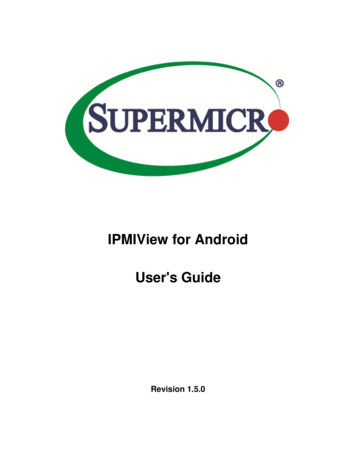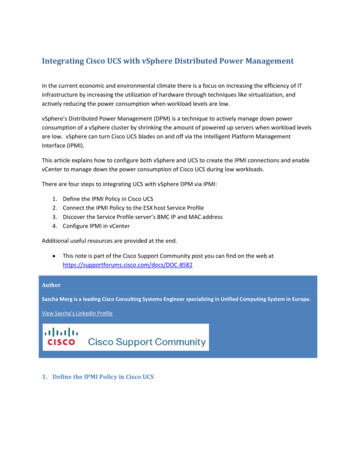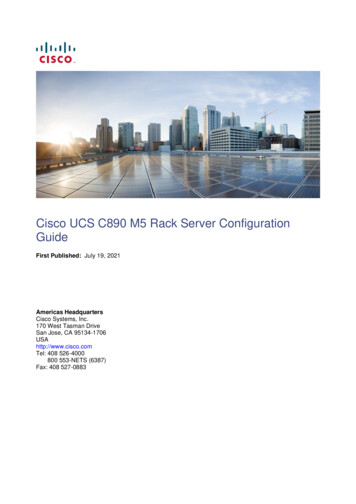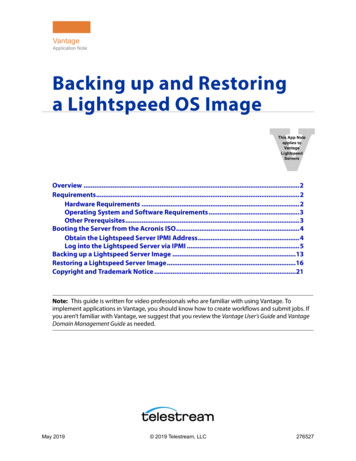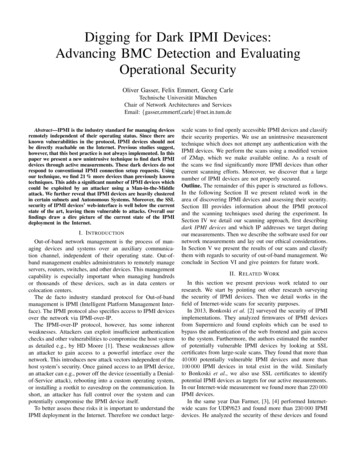
Transcription
Digging for Dark IPMI Devices:Advancing BMC Detection and EvaluatingOperational SecurityOliver Gasser, Felix Emmert, Georg CarleTechnische Universität MünchenChair of Network Architectures and ServicesEmail: I is the industry standard for managing devicesremotely independent of their operating status. Since there areknown vulnerabilities in the protocol, IPMI devices should notbe directly reachable on the Internet. Previous studies suggest,however, that this best practice is not always implemented. In thispaper we present a new unintrusive technique to find dark IPMIdevices through active measurements. These dark devices do notrespond to conventional IPMI connection setup requests. Usingour technique, we find 21 % more devices than previously knowntechniques. This adds a significant number of IPMI devices whichcould be exploited by an attacker using a Man-in-the-Middleattack. We further reveal that IPMI devices are heavily clusteredin certain subnets and Autonomous Systems. Moreover, the SSLsecurity of IPMI devices’ web-interface is well below the currentstate of the art, leaving them vulnerable to attacks. Overall ourfindings draw a dire picture of the current state of the IPMIdeployment in the Internet.I. I NTRODUCTIONOut-of-band network management is the process of managing devices and systems over an auxiliary communication channel, independent of their operating state. Out-ofband management enables administrators to remotely manageservers, routers, switches, and other devices. This managementcapability is especially important when managing hundredsor thousands of these devices, such as in data centers orcolocation centers.The de facto industry standard protocol for Out-of-bandmanagement is IPMI (Intelligent Platform Management Interface). The IPMI protocol also specifies access to IPMI devicesover the network via IPMI-over-IP.The IPMI-over-IP protocol, however, has some inherentweaknesses. Attackers can exploit insufficient authenticationchecks and other vulnerabilities to compromise the host systemas detailed e.g., by HD Moore [1]. These weaknesses allowan attacker to gain access to a powerful interface over thenetwork. This introduces new attack vectors independent of thehost system’s security. Once gained access to an IPMI device,an attacker can e.g., power off the device (essentially a Denialof-Service attack), rebooting into a custom operating system,or installing a rootkit to eavesdrop on the communication. Inshort, an attacker has full control over the system and canpotentially compromise the IPMI device itself.To better assess these risks it is important to understand theIPMI deployment in the Internet. Therefore we conduct large-scale scans to find openly accessible IPMI devices and classifytheir security properties. We use an unintrusive measurementtechnique which does not attempt any authentication with theIPMI devices. We perform the scans using a modified versionof ZMap, which we make available online. As a result ofthe scans we find significantly more IPMI devices than othercurrent scanning efforts. Moreover, we discover that a largenumber of IPMI devices are not properly secured.Outline. The remainder of this paper is structured as follows.In the following Section II we present related work in thearea of discovering IPMI devices and assessing their security.Section III provides information about the IPMI protocoland the scanning techniques used during the experiment. InSection IV we detail our scanning approach, first describingdark IPMI devices and which IP addresses we target duringour measurements. Then we describe the software used for ournetwork measurements and lay out our ethical considerations.In Section V we present the results of our scans and classifythem with regards to security of out-of-band management. Weconclude in Section VI and give pointers for future work.II. R ELATED W ORKIn this section we present previous work related to ourresearch. We start by pointing out other research surveyingthe security of IPMI devices. Then we detail works in thefield of Internet-wide scans for security purposes.In 2013, Bonkoski et al. [2] surveyed the security of IPMIimplementations. They analyzed firmwares of IPMI devicesfrom Supermicro and found exploits which can be used tobypass the authentication of the web frontend and gain accessto the system. Furthermore, the authors estimated the numberof potentially vulnerable IPMI devices by looking at SSLcertificates from large-scale scans. They found that more than40 000 potentially vulnerable IPMI devices and more than100 000 IPMI devices in total exist in the wild. Similarlyto Bonkoski et al., we also use SSL certificates to identifypotential IPMI devices as targets for our active measurements.In our Internet-wide measurement we found more than 220 000IPMI devices.In the same year Dan Farmer, [3], [4] performed Internetwide scans for UDP/623 and found more than 230 000 IPMIdevices. He analyzed the security of these devices and found
that many were vulnerable to authentication weaknesses andthat passwords could be brute-forced. Although we foundslightly less devices in 2015 than Dan Farmer in 2013, wefound many dark IPMI devices, i.e., devices which do notrespond to Farmer’s scanning technique.Zhang et al. [5] in 2014 tried to correlate the maliciousnessof networks (e.g., sending spam emails) with mismanagement metrics. One of their mismanagement metrics was thereachability of IPMI devices within Autonomous Systems(ASes). By matching regular expressions on the subject fieldin SSL certificates, they identified about 100 000 publiclyreachable IPMI devices in different ASes. We use a similartechnique to match found IPMI devices to vendors. They founda weak correlation between the reachability of IPMI devicesin networks and the maliciousness of a network.In 2014, Costin et al. [6] performed a large-scale analysisof embedded firmwares. They gathered firmware images usinga web-crawler and a site where users could upload theirfirmware. Then the authors analyzed more than 32 000 of themand found 38 new vulnerabilities. Moreover, they were ableto extract private SSL keys and crack hard-coded passwordhashes.Similarly, Stefan Viehböck analyzed more than 4000 embedded firmware images in 2015 [7]. Unfortunately, most ofthe issues previously found still persist: the author was able toextract 580 unique private keys. These keys are used by 9%of all SSL hosts on the IPv4 Internet and 6% of SSH hosts.Rapid7 performs monthly IPMI scans and publishes the rawresponse packets as part of Project Sonar [8]. Compared totheir scanning efforts we use a different scanning technique(see Section III-D) which leads to more detected IPMI devices.Large-scale network measurements have recently becomea valuable tool to assess specific aspects of the Internet’ssecurity. Holz et al. [9] conducted active and passive measurements in 2011 to assess the security of the SSL PKI.They identified multiple security issues in the SSL deploymentsuch as incorrect certificate chains and invalid subject namesin certificates.In 2012, Heninger et al. [10] evaluated the cryptographicproperties of SSL and SSH. They concluded that due to alack of randomness, many keys were predictable.In 2014, Gasser et al. [11] conducted multiple Internetwide SSH scans. They were able to confirm many ofHeninger et al.’s findings and additionally found duplicate yetcryptographically strong keys.Similar to Heninger et al., we analyze the SSL certificatesof web interfaces to evaluate the security of IPMI devices. Thecertificates found on IPMI devices are not suitable to properlysecure connections.III. BACKGROUNDIn this section we will give general information about Outof-band network management. Then we provide insights intothe protocols relevant for this research.server (BMC)clientGet Channel Authentication Capabilities Rq.Get Channel Authentication Capabilities Rs.DiscoveryActivationRMCP Open Session Rq.RMCP Open Session Rs.RAKP Message 1RAKP Message 2RAKP Message 3RAKP Message 4.Fig. 1. IPMI-over-IP connection establishment in IPMI 2.0.A. Out-of-Band Network ManagementOut-of-band network management is a term describingdifferent technologies enabling system administrators to remotely manage their network hardware (e.g., switches, routers,servers,. . . ) independently of the system’s operating state.This goal is commonly achieved by independent sub-systemsconnected to the main system’s network hardware. Thesesub-systems run their own operating system on dedicatedhardware. They are connected to various I/O ports of the mainsystem. Out-of-band network management devices have theirown network interface controllers (NICs) or at least access toone of the main system’s NICs via a “side-band” interface.Out-of-band management devices commonly provide somesort of management interfaces for administrators like webinterfaces or access via SSH.B. IPMI BasicsIntelligent Platform Management Interface (IPMI) is the defacto industry standard for Out-of-band network managementdevices used for server management. The IPMI specification[12] defines the architecture, different functionalities, anduser interfaces of Out-of-band network management devicesfor servers. IPMI devices run on embedded microcontrollerscalled Baseboard Management Controller (BMC). BMCs arecommonly installed via daughter cards or directly integrated inthe server’s mainboard. IPMI’s functionality may be extendedby BMC manufacturers. A common example for such anextension are web interfaces on TCP ports 80 (HTTP) and443 (HTTPS).C. IPMI-over-IPIPMI defines its own network protocol called IPMI-overIP which uses UDP port 623 [12]. IPMI-over-IP allows foradministrators to remotely login to their BMCs and perform
a set of actions like rebooting the server or configuring theBMC. Using IPMI-over-IP, it is possible to take full controlover the connected server. If not needed, most devices offerthe possibility to deactivate IPMI-over-IP.IPMI-over-IP has been introduced in version 1.5 of the IPMIspecification. It has been updated in the new version 2.0 of theIPMI specification. However, IPMI version 2.0 devices are stillrequired to simultaneously support the old version 1.5 [12].In the following we describe how an IPMI-over-IP connection is established and authenticated. IPMI-over-IP’s connection establishment is divided in two phases, “Discovery” and“Activation” (see Figure 1 for IPMI version 2.0).In the optional “Discovery” phase of the IPMI-over-IP protocol in version 2.0 of the IPMI specification, the client sends aGet Channel Authentication Capabilities Request packet to theBMC. The BMC answers using a Get Channel AuthenticationCapabilities Response packet. This response packet includesthe IPMI version and authentication methods supported bythe BMC. If IPMI-over-IP is deactivated, the BMC will notrespond.In version 1.5 of the IPMI specification, IPMI-over-IP alsosupports discovery using RMCP Ping packets. If probed,the BMC responds by sending an RMCP Pong packet. Thisresponse packet does not include much information other thanwhether or not IPMI is supported. However, small-scale testson a Dell iDRAC 7 show that the BMC replies to RMCPPing packets even if the IPMI-over-IP protocol has beendeactivated.The “Activation” phase of the IPMI-over-IP protocol is onlydescribed in version 2.0 of the IPMI specification, the olderversion 1.5 is out of scope for this paper.The “Activation” phase of the IPMI-over-IP protocol in version 2.0 of the IPMI specification starts with the client sendingan RMCP Open Session Request packet to the BMC whichresponds with an RMCP Open Session Response packet.These packets contain session IDs for further communicationbetween client and BMC. The response packet also containsinformation about supported cipher suites.Next, the client sends an RAKP Message 1 packet answeredby the BMC with an RAKP Message 2 packet. These packetscontain nonces for mutual authentication (later signed usingthe user’s password) as well as the client’s username and theBMC’s GUID (globally unique ID). Since the RAKP Message 2 packet is already signed using the password of therequested username, it is possible to perform an offline bruteforce attack on the password if the requested username is valid.It is also possible to perform an online brute-force attack on theusername, since the BMC tells the client whether the usernameis valid or not.Finally, the client sends a signed RAKP Message 3 packetanswered by the BMC with a signed RAKP Message 4 packet.The signature is made using the user’s password similar to theRAKP Message 2 packet.D. Different Scan TypesIt is possible to scan for IPMI devices in various ways.The IPMI-over-IP protocol defines two different discoverymethods, both over UDP port 623.BMCs queried with Get Channel Authentication Capabilities Request packets only reply if the IPMI-over-IP protocolhas been activated. The response packet contains informationabout the IPMI version of the BMC (1.5 or 2.0) as well assome information about supported authentication methods.BMCs scanned with RMCP Ping packets reply with RMCPPong packets. The response packets contain little to no information about the BMC other than its presence. However,small-scale tests on a Dell iDRAC 7 device show that theBMC replies to RMCP Ping packets even if the IPMI-over-IPprotocol has been deactivated. That is why we presume to findadditional dark IPMI devices by scanning with RMCP Pingpackets.E. SSL BasicsSSL is a security protocol based on a Public Key Infrastructure. It is used in the WWW, but also for email, chats, andother services. SSL certificates contain identity informationabout a peer (e.g., a domain name) and a correspondingpublic key. A certificate therefore creates a binding betweenan identity and a public key.We will use SSL certificates in our research in the followingtwo ways: First, to identify potential IPMI devices for scanning(see Section IV-B). Second, to evaluate the security of IPMIdevices with regards to cipher security and the potential ofMan-in-the-Middle attacks (see Section V-D1).IV. A PPROACHIn this section we describe the rationale and approach ofour IPMI measurements. We begin by explaining the conceptof dark IPMI devices. Then, we detail the two types ofmeasurements: The first one is limited to a small subset ofIP addresses including likely dark IPMI devices. The secondtype of measurement is a complete scan of the IPv4 space.Finally, we detail the used scanning software and addressethical questions regarding active network measurements.A. Dark IPMI DevicesWith our measurements we want to discover dark IPMIdevices. These are devices which have the IPMI-over-IP portdisabled. Consequently they do not respond to standard IPMIscans such as those executed by Rapid7 [8]. They do, however,respond to RMCP Ping requests as required by the IPMIspecification [12]. Even though dark IPMI devices do notprovide direct IPMI-over-IP access, they are still valuable toattackers. Once identified as an IPMI device, attackers couldexploit other attack vectors, e.g., flaws in the web interfaceimplementation or insecure SSH connections [13] to gainaccess to the BMC or the host system.
D. Ethical ConsiderationsDownload datafrom Project SonarSSL HostsIPMI Hostssubstract IPMIhosts fromSSL hostsTargetsScan using ZMapResultsFilter out malformed andunrelated packetsResultsFig. 2. Flow chart of discovering dark IPMI devices used in the first scan.B. Target ListIn order to verify that there are indeed dark IPMI devices,we execute active measurements on a specific subset of IPaddresses. As a starting point we use all SSL hosts identifiedby Project Sonar [8] as most IPMI devices provide accessvia a web interface. Then, we remove the IP addresses whichalready responded to standard IPMI scans using Get ChannelAuthentication Capabilities requests. These IP addresses havealready been attributed to IPMI devices and are therefore notdark. We use the remaining IP addresses in the first type ofactive measurements. Figure 2 shows the workflow of this typeof measurement.In the second type of active measurements we probe the fullIPv4 space to get a complete picture of IPMI deployment.C. ZMapZMap is a network analysis tool designed for scanningdifferent network ports across the IPv4 Internet [14]. ZMaphas been optimized for speed, meaning that it is capable ofscanning the entire IPv4 space in less than 5 minutes givenenough bandwidth [15]. It is possible to load custom modulesfor packet generation or result processing.We built a probe module for ZMap which generates RMCPPing packets. Moreover, we extended ZMap to filter outincoming UDP packets that are not addressed to the scanningmachine (e.g., multicast packets). The modified version isavailable on our website.11 zActive network measurements have to be conducted in asensible and ethical way in order not to induce negativeconsequences. Partridge and Allman [16] propose to evaluatewhether the active measurements themselves or the releaseof the resulting data can harm an individual. Therefore weapply precautionary measures to reduce the impact of our IPMIscans.First, we try to minimize the load on target networks generated by our research activities. Therefore, we do not scan withmaximum speed but rather constrain our scans to 1 Mbit s 1and 10 Mbit s 1 respectively. Additionally, ZMap’s randomization feature ensures an even distribution of probes destinedto a subnet over time.Second, we use RMCP Ping requests which are less intrusive compared to Get Channel Authentication Capabilities requests. An RMCP Ping request does not attempt anyauthentication or login. No sensitive information other thanthe existence of the device itself is sent in the RMCP Pongresponse message. Furthermore, it does not show up in theIPMI device’s log file, additionally reducing the number offalse alarms.Third, we set up a web site on the scanning machine withinformation about our research activities. Moreover, we provide a dedicated email address for information and blacklistingpurposes. We offer network administrators the possibility tosend their emails encrypted with our PGP key.Fourth, we exclude IP addresses whose network administrator indicated in the past that they did not want to bescanned. Before our experiments the blacklist contained 148entries resulting in 2 079 222 IP addresses. During our scanswe received only two emails which were automatically sentby intrusion detection systems to the abuse contact listed inthe WHOIS database. We answered both emails by providingmore information with regards to our activity and offered thenetwork administrators to put their IP ranges on our blacklist.We did, however, not receive a reply.Fifth, we conduct an internal review at our Chair beforestarting any network experiment. This ensures that ethical andprocedural concerns are addressed in advance and multipleviewpoints are being considered.This research is conducted under consideration of the twoethical questions raised by Partridge and Allman [16]. Webelieve that the five precautionary measures ensure that thecollection of data in this study does not cause tangible harmto any person’s well-being. Furthermore, since we do not haveplans to release the collected data, no private or confidentialinformation is published. The results presented in this papergive a general overview but no one specific individual or hostis identified.V. E VALUATIONIn this section we present the results from the two scansconducted during this work. First, we will give an overviewof the two scans. Then we will go into detail with regards tothe responding hosts by comparing our measurement technique
TABLE IOVERVIEW OF B OTH S CANSHTTPS hosts w/o known IPMI hostsComplete IPv4 spaceNumber of targetsResponding IPsValid responsesHit rateScanning rateDuration33 131 5983 700 190 40138 180400 29937 205225 6120.11 %0.01 %1 Mbit s 110 Mbit s 17 h 52 min 44 s2 d 21 h 5 min 11 swith the state of the art. Following, we evaluate deploymentpractices and uncover significant clustering in certain parts ofthe network. Then, we evaluate the security of IPMI device,specifically their SSL certificates and the supported IPMIversions. Finally, we classify the evaluated results and giveconcrete advice on hardening IPMI deployments in a network.A. Scan OverviewWe conducted two active measurement runs: the first wasconducted on likely newly discoverable IPMI hosts, the secondwas on the complete IPv4 space. Table I shows an overviewwith statistics about both scans.The first scan’s purpose was to gather additional active IPMIhosts compared to other IPMI scanning projects. In contrastto Project Sonar’s regular IPMI scans [8] which use GetChannel Authentication Capabilities packets, we use RMCPPing packets (see Section III-D). This allows us to find IPMIdevices which do not answer to Get Channel AuthenticationCapabilities requests. These dark devices have IPMI-overIP deactivated, however other network interfaces (e.g., webinterface) might still be accessible. Therefore RMCP Pingrequests allow us to estimate the number of accessible IPMIdevices more accurately. We decided to scan all hosts with SSLcertificates minus the IPs where an IPMI device has alreadybeen detected by Get Channel Authentication Capabilitiesscans. Thus the responding IPs are IPMI devices which couldnot be detected by Get Channel Authentication Capabilitiesscans because the IPMI-over-IP interface has been disabled.These devices do not pose a direct security risk as IPMI-overIP is disabled. However, other access methods such as the webinterface still pose a threat as shown by Bonkoski et al. [2].The second scan covers the complete IPv4 space. Thisallows us to find all publicly accessible IPMI devices in theIPv4 Internet and therefore gives us the complete picture.For both scans we used the scanning tool ZMap [14] (seeSection IV-C for more details). We used a blacklist to excludehosts and subnets whose network administrators did not wantto be scanned. Both scans were run from a physical machineon a mid-range server with a quad core Intel Core i7 CPU and8 GiB RAM, the operating system was Debian 8 Jessie.B. Responding HostsIn our first scan on 33 131 598 target IPs we receivedreplies from 38 180 different IPs. After filtering out malformedand unrelated packets, 37 205 valid responses were left. Thiscorresponds to a hit rate of 0.11 %. Since we excluded the2 According to remarks by Rapid7 employees the strange valley betweenFebruary and March 2015 in Figure 3 is most likely a measurement 9.201510.201511.201512.2015Targets12Valid ResponsesScanDateFig. 3. Number of valid responses from Project Sonar’s IPMI data sets overtime.2 Note the crunched y axis for increased readability.results of Project Sonar’s IPMI scans from our target list,these responses come from dark IPMI devices, i.e., deviceswith IPMI-over-IP disabled.Our second scan was conducted on the entire IPv4 spaceminus our blacklist. We got replies from 400 299 differentIPs with 225 612 valid responses from IPMI devices. Thiscorresponds to a hit rate of 0.01 %.We compared our results with Project Sonar’s IPMI scanfrom September 7, 2015. We removed 720 blacklisted IPsfrom Project Sonar’s results to improve the comparability.Our second scan delivered 21.22 % more results than ProjectSonar’s IPMI scan. This shows that our scanning approachis able to identify significantly more IPMI devices than otherstate of the art scanning methods.When comparing our results to scans conducted by DanFarmer in 2013 [4], we find slightly less devices than his230 000. However, this can be explained by the general decrease of reachable IPMI devices over time. Figure 3 showsthe number of valid IPMI responses obtained from ProjectSonar scans between June 2014 and December 2015. Notethat the y axis of the figure is crunched to increase readability.We can clearly see that the number of valid responses isdropping steadily, by a total of 65 090 devices in the observedperiod. The decreasing number of IPMI host could be a resultof previous work pointing out security risks with IPMI [2],[5], [6]. In consequence, network administrators might haveisolated IPMI devices from the public Internet. Unfortunately,
TABLE IIT OP 10 AS ES W ITH M OST IPMI D EVICESFig. 4. Hilbert curve of responding IPMI devices in the second scan.we could not compare our measurement method with DanFarmer’s as no detailed description was provided. Finally, DanFarmer did not specify whether a blacklist was used during hisscans.C. Deployment PracticesIn this section we evaluate the results of the second scancovering the complete IPv4 space with regards to deploymentpractices. The question arises if we can find certain subnetswith a significantly higher IPMI density.To better visualize connected subnets but not constrainingourselves to a certain prefix length we use a Hilbert spacefilling curve. Figure 4 shows the distribution of identified IPMIdevices during the second scan. The figure shows a heat map ofthe IPMI deployment in the complete IPv4 space. We visuallyhighlight /8 networks to make it easier to find specific parts ofthe Internet. Each pixel represents one /18 network, the colorindicates the number of IPMI devices found in this /18, rangingfrom blue (few IPMI devices) to red (many IPMI devices).We can see that generally the IPv4 space is sparsely populated with IPMI devices. This is no surprise and correspondsto the hit rate of 0.01 %. However, IPMI devices are notuniformly distributed over the IPv4 space. They seem tobe concentrated in some subnets whereas other subnets arecompletely blank indicating that no IPMI device is reachablefrom the public Internet. We suspect that the former could bestemming from data centers and hosting providers, whereas thelatter would include private customers including DSL, cable,and fiber lines. To further analyze this scenario we take a lookat parts of the Internet with a high IPMI density in more detail.Thus we evaluate the density of IPMI devices based onAutonomous Systems S-TECHOPQUniv. de Baja CaliforniaOKB MEINOVACIARedstation LimitedLeaseWeb-NLSANETEnzu Inc# IPMI Devices30 308544746874140379632813132283628302810We apply CAIDA’s Prefix to AS mapping [17] to match IPaddresses to their respective Autonomous Systems.3 We findIPMI devices in a total of 7580 ASes. Table II shows the top10 ASes with the most IPMI devices. It is astounding that thetop AS owned by NTT Communication has more than 30 000IPMI devices. NTT is a provider of network managementsolutions. The AS of NTT has more IPMI devices than the nexteight ASes combined. Since NTT is one of the largest networkservices providers announcing numerous IPv4 prefixes (e.g.,also for the Akamai CDN) and operating one single global ASthis is not surprising.The rest of the top 10 ASes is with three exceptions madeup of hosting providers. Two entries are ASes pertaining toacademic institutions from Mexico and Slovakia respectively.Interestingly, one AS is a special Russian agency (“Experimental Design Bureau“) for the purpose of developing aerospaceand land-based antenna systems. For research purposes theyalso operate their own supercomputer.As can be seen in Table II the number of IPMI devicesper AS steeply decreases. In addition, Figure 4 further suggests that there are a few networks with many IPMI deviceswhereas most have little to none. To further investigate thisphenomenon we plot the cumulative distribution function ofIPMI devices in Autonomous Systems. Figure 5 shows thepercentage of IPMI devices per AS. Note that the x axis’scale is logarithmic as otherwise the function would almostimmediately rise to the top due to the exponential increase.We see that the top 10 ASes are home to almost 30 %of the Internet’s IPMI devices. As expected, the number ofIPMI devices added per additional AS sharply decreases: Theincrease from 10 to 100 ASes adds about 30 % of IPMIdevices, the same percentage as from AS 100 to AS 1000.To conclude, IPMI devices are not uniformly distributed inthe Internet, but rather concentrated in specific subnets (seeFigure 4) and Autonomous Systems (see Table II and Figure 5). This hints at a general deployment issue with regardsto IPMI: some network administrators and organizations do notseem to deem it necessary to secure their IPMI deploymentwhich leaves them open to exploitation.3 MOAS are counted towards one AS only (according to CAIDA’s deterministic sorting).
1.00.80.80.60.6Pr [x k]% of all IPMI devices1.00.40.40.20.20.0 01010 110 2Number of ASes10 410 3Fig. 5. Cumulative Distribution Function of IPMI Devices in AutonomousSystems in the Second Scan. Note: The x axis is log-scaled.0.0512 1,0242,0484,096Key length kFig. 7. Cumulative distribution function of SSL key lengths in the 1st FujitsuLenovoIntelRaritanIBMOracleCheck 5101102103Number104105Fig. 6. BMCs of the first scan by vendor. Note: The x axis is log-scaled.D. Security Analysis1) SSL Evaluation: Since the target list of our first scan isbased on SSL scan data published by Project Sonar, we areable to analyze the SSL certificates of the first scan’s results.First, we examine the use of default certificates in BMCs byconsidering the Common Names (CNs) and SHA1 checksumsof the certificates. We find that 83.31 % of BMCs use defaultcertificates, whereas 2.74 % of BMCs use custom generatedcertificates. A special case are 13.95 % of BMCs which seemto auto-generate their certificates upon installation. Theseexhibit the same CN schema but differ in th
Get Channel Authentication Capabilities Request packet to the BMC. The BMC answers using a Get Channel Authentication Capabilities Response packet. This response packet includes the IPMI version and authentication methods supported by the BMC. If IPMI-over-IP is deactivated, the BMC will not respond.


